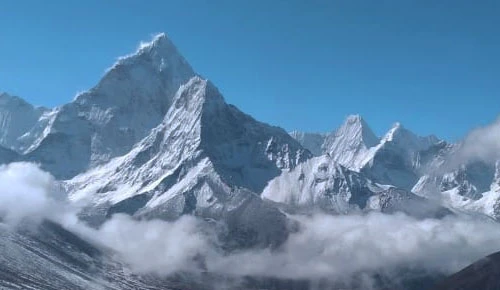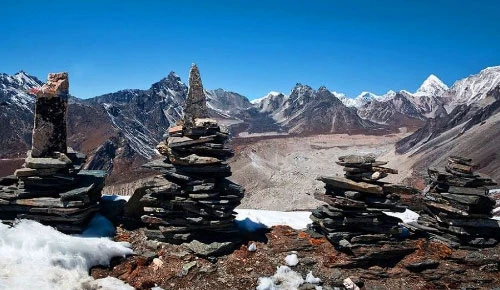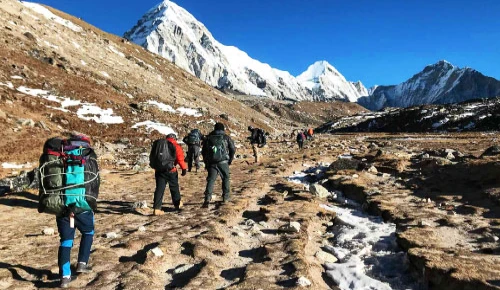Khaptad National Park
Khaptad National Park is a pristine shelter known for its varied flora and wildlife, calm beauty, and spiritual importance. This park is located in a remote western area of Nepal.
The park, which has a total area of around 225 square kilometers, was created in 1984 and is named for the well-known yogi Khaptad Baba, who meditated in the area for a large portion of his life.
The park's terrain is diverse, with curved meadows blanketed in vibrant wildflowers and lush woods of chir pine, oak, rhododendron, and fir. With an altitude that varies from 1,400 to 3,300 meters above sea level.
It provides a home for a wide variety of animals, including the critically endangered red panda, the Himalayan black bear, the leopard, the barking deer, and many bird species, including vultures, eagles, and pheasants.
Khaptad National Park is unique because of its spiritual and cultural value. It draws pilgrims and spiritual seekers from all over the world since it is home to a large number of holy sites and hermitages.
Many people come to the park in search of comfort among the peace of nature because it offers an ideal location for meditation and reflection.
Khaptad offers plenty of hiking and trekking routes that wind through lush woods, green meadows, and past charming towns. Nature lovers can take part in a variety of activities at the park, such as stargazing and birding, as well as camping beneath the stars.
Khaptad National Park, which has been preserved as a sanctuary for spirituality and wildlife, is evidence of Nepal's dedication to sustainable tourism and conservation.
For anyone searching for a genuine wilderness experience combined with spiritual renewal, it is an absolute must-visit location due to its natural beauty and cultural diversity.
Essential Information on Khaptad National Park
Feature | Information |
Area | 225 sq. km. (87 sq. mi.) |
Location | Far-Western Region, Nepal (spanning Bajhang, Bajura, Achham, and Doti districts) |
Buffer Zone | 216 sq. km (83 sq. mi) |
UNESCO World Heritage Site | No |
Established | 1984 |
Species | Over 567 flora species, 20+ mammal species, diverse bird and insect life |
Activities | Trekking, bird watching, cultural exploration, religious pilgrimage |
Key Attractions | Khaptad Baba Ashram, panoramic Himalayan views, Ramaroshan (Pancha Pura), 12 lakes |
Entry Fees | Domestic visitors: NPR 300, Foreigners: NPR 1000 (subject to change, confirm with official sources) |
Table of Contents
History of Khaptad National Park
Khaptad National Park was not officially designated until 1984; however, its significance dates back even before that era. The region that currently makes up the park has long been valued for both its spiritual and natural beauty.
Khaptad Baba, a highly esteemed Hindu guru who lived and meditated in the area throughout the 20th century, is largely responsible for the popularity of Khaptad National Park. His teachings and spiritual presence attracted followers and devotees to the region, which helped to establish it as a sacred spot.
The Nepalese government began taking action to save the area in the 1970s after realizing how important the ecosystem was. In 1976, the region received the designation of a wildlife reserve, which set the stage for its future conversion into a national park. Khaptad National Park was formally created in 1984 and covers an area of around 225 square kilometers. The development of the park was motivated with the aim of protecting its rich biodiversity.
The park is home to a vast range of plant and animal species, as well as its different habitats, which include wetlands, meadows, and woods. The Department of National Parks and Wildlife Conservation of the Nepalese government has been in charge of overseeing Khaptad National Park ever since it was founded.
The park's conservation efforts have been concentrated on maintaining its natural ecosystems, safeguarding endangered animals, and encouraging eco-friendly travel. This National Park has grown in popularity over time among local and foreign visitors looking for chances for spiritual retreats, animal viewing, and natural discovery. Inside Nepal's network of protected areas, its peaceful surroundings, cultural value, and stunning scenery never fail to captivate tourists.
Buffer Zone
The buffer zone around Khaptad National Park acts as an important biological transition zone, promoting a balanced relationship between human settlements and the protected wildness. This buffer zone, which includes lush woods, green meadows, and streams that flow downhill, is very important for protecting biodiversity while still allowing people to do sustainable things. Local people can do eco-friendly jobs like agroforestry and ecotourism because the forest protects them from encroachment and fights between people and animals.
Furthermore, the buffer zone serves as a corridor for wildlife movement, which promotes genetic exchange and species distribution. The buffer zone of Khaptad National Park takes a whole-person approach to conservation by encouraging wildlife and people to live together peacefully. This will protect this natural treasure for future generations.
Flora and Fauna of Khaptad National Park
Renowned for its abundant and varied flora and wildlife, Khaptad National Park is home to a wide range of habitats, from alpine meadows to temperate woods. An overview of the park's vegetation and animals can be obtained here:
Flora
The flora of Khaptad National Park is abundant, with over 567 species that have been identified. These feature vivid alpine meadows covered with wildflowers such as gentians, primulas, and rhododendrons, which are Nepal's national flowers.
Diverse subtropical broadleaf woods are brimming with ferns, mosses, and orchids, while temperate broadleaf forests are thriving with oaks, maples, and chestnuts. The park's extraordinary diversity of plants is a reflection of its varying elevation and climate.
- Chir pine, mixed broad-leaved oak, rhododendron, and hemlock forests are among the many types of forests that make up the park. Numerous plant species find home in these woodlands, which also sustain a robust ecology.
- Khaptad National Park is home to a variety of rhododendron species, whose vivid blossoms, especially in the spring, provide pops of color to the surrounding scenery.
- The park is abundant in medicinal plants, which the local people have long employed for a variety of purposes, including spiritual and medical rituals.
- The park is home to a large number of alpine meadows and grasslands, especially at higher elevations. These areas serve as crucial grazing areas for wildlife and are home to a wide variety of plant species.
Fauna
The wildlife in Khaptad National Park is abundant, with over 20 kinds of animals known to exist. This includes elusive creatures like the wild dog, musk deer, and Himalayan black bear. The park is also home to a wide variety of birds, with over 270 species identified.
- The critically endangered red panda is among Khaptad National Park's most recognizable residents. These elusive animals, which live in the park's deep forests, are a representation of the importance of the area for conservation.
- The Himalayan black bear is one of the park's iconic animals. When tourists explore the park, they frequently come upon these bears, which are always roaming the woodlands in quest of food.
- Although they are more elusive than other large predators, leopards can be found in Khaptad National Park. They are essential to controlling prey numbers and preserving the ecological equilibrium of the park.
- A frequent ungulate species in the park is the barking deer, sometimes known as the muntjac.
- With over 270 kinds of birds identified within its borders, the park is a birdwatcher's delight. Khaptad National Park provides a wealth of chances for birding aficionados, ranging from magnificent raptors such as eagles and vultures to vibrant pheasants and songbirds.
Activities to do in Khaptad National Park
Trekking: The stunning hiking paths in Khaptad National Park meander through villages, meadows, and woodlands. Hikers may take multi-day excursions to explore the park's varied landscapes and enjoy breathtaking Himalayan views.
Viewing Wildlife: To see the park's varied wildlife, which includes the elusive red panda, Himalayan black bear, leopard, barking deer, and several bird species, wildlife enthusiasts can go on guided trips. The best times of day to see animals are in the early morning and late afternoon.
Birdwatching: Khaptad is a birdwatcher's delight, with over 270 species of birds identified in the park. To see diverse songbirds, regal raptors, and vibrant pheasants in their native environment, pack your binoculars and camera.
Cultural exploration: Visit traditional villages to learn about the habits and way of life of the local people. This is a great way to learn about the region's cultural history. To understand the spiritual importance of the place, you can also go to religious sites.
Camping: If you want to spend a night beneath the stars, you may camp in the park in specific spots. Unwind over a campfire and take in the starry sky while you take in the peace and quiet of the outdoors, the fresh mountain air, and the sounds of nature.
Yoga and meditation: Khaptad National Park's calm surroundings make it the perfect place to practice yoga and meditation. In order to restore your mind, body, and soul, find a peaceful area among the meadows or woodlands.
Villages near Khaptad National Park
There are various villages near Khaptad National Park. Each of these villages has its own distinct beauty and cultural experience. The following are a few well-known settlements close to the park:
Silgadi: Silgadi acts as a point of entry for guests. It's a little community with modest services, including tea shops, guesthouses, and stores that provide trekking necessities.
Bajhang: Bajhang is situated in the Bajhang District. Offering lodging choices and other amenities, it acts as a base for hikers and pilgrims visiting the park.
Chainpur: Chainpur is a charming town in the Bajhang District. It provides lodging choices and markets for resupply while acting as a hub for visitors bound for Khaptad National Park.
Tribeni: Tribeni is a little settlement situated at the meeting of three rivers. Offering a tranquil setting and chances for cultural immersion, it is a well-liked rest point for pilgrims and hikers visiting the park.
Chandannath: Chandannath is a medieval town located in Jumla District. It is the location of Chandan Nath Temple, one of the most important pilgrimage sites in the area, that draws worshippers from all around.
Talium: Talium is a quaint town close to Khaptad National Park. For tourists looking for peace and stunning scenery, this place is perfect.
Entry Fees for Khaptad National Park
The entry fees for this national park are as follows:
- Nepali Citizens: Rs. 100 Per Person
- SAARC Nationals: Rs. 500 Per Person (SAARC countries include Afghanistan, Bangladesh, Bhutan, India, Maldives, Pakistan, and Sri Lanka)
- Foreigners: Rs. 1500 Per Person
Note : Children under the age of 10 get free entry to this national park.
Important Policies while visiting Khaptad National Park
- Before visiting the park, you must get permits and pay the entrance costs.
- Respect wildlife by keeping a safe distance from it and not feeding or bothering it.
- By picking up after yourself, reducing your environmental effects, and protecting natural and cultural areas, you can adhere to the Leave No Trace philosophy.
- Respect the boundaries of approved camping places and abide by the rules on campfires, disposing of garbage, and interacting with wildlife.
- When visiting the nearby villages and holy places, remember the local customs, culture, and heritage.
- Don't pick or harm the park's flowers, plants, or other natural treasures.
- Observe safety procedures for adverse weather and carry the appropriate equipment when participating in outdoor activities like trekking, hiking, and camping.
- Be considerate of other guests' noise levels and refrain from upsetting animals or other visitors with loud activities or music.
- Practice responsible photography by respecting the privacy and cultural sensitivities of local communities.
Glimpse into the Enchanting Khaptad National Park
Khaptad National Park is a pristine refuge that combines spiritual importance, cultural depth, and magnificent natural beauty.
Trekkers, nature lovers, and spiritual searchers may all find refuge in the park's serene meadows, abundant wildlife, and hallowed locations.
Visitors may help preserve this amazing environment by adhering to its regulations, which will guarantee that Khaptad is a sought-after destination for many years to come.
With its ageless charm and promise of an amazing experience in the heart of the Himalayas, Khaptad National Park welcomes those seeking adventure, spiritual renewal, or just a peaceful getaway into nature.








